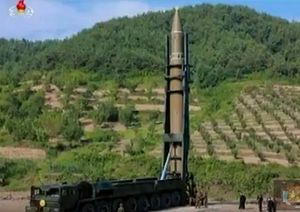North Korea may soon conduct a second test of its two-stage, liquid-fueled Hwasong-14 (KN20) intercontinental ballistic missile (ICBM), The Diplomat has learned from a U.S. government source with knowledge of North Korea’s weapons programs.
The test is likely to occur from near Panghyon Airport or elsewhere near Kusong, in North Korea’s North Pyongan province. North Korea’s first-ever ICBM flight-test was launched from a launchpad near Panghyon Airport.
U.S. military intelligence has spotted a Hwasong-14 transporter-erector and firing-table transporter in Kusong, the source tells The Diplomat. While road-mobile, the Hwasong-14 ICBM, at least in its testing and development configuration, requires a static firing-table for launch.
The transporter-erector is likely the same modified WS51200 Chinese-origin logging truck that was seen in released footage of the July 4 test.
The ICBM test launch could take place as soon as Tuesday, ahead of July 27, which is celebrated as “Victory Day” in the Korean War in North Korea.
North Korea does not always conduct missile tests to coincide with auspicious dates or public holidays, but testing in recent years, under Kim Jong-un’s leadership, has often come within days of prominent holidays.
The test would come as the international community remains divided over an appropriate reaction to North Korea’s July 4 test.
The United Nations Security Council remains at an impasse over its response to the July 4 launch as the Russian Federation continues to insist that North Korea tested an intermediate-range ballistic missile on that day, according to Russian intelligence data.
What to Look For in a Second KN20 Test
North Korea could look to test several parameters of the ICBM with its anticipated upcoming test. For instance, as Jeffrey Lewis has suggested, the capability demonstrated during the July 4 test of the Hwasong-14 may have been deceptive about the maximum strike range of the new missile.
Since its exceptionally provocative 1998 test of the Taepodong-1 satellite launch vehicle, North Korea has not conducted a ballistic missile or satellite launch that has overflown Japan.
Constrained by this self-imposed restriction on overflying Japan, North Korea has repeatedly fired its medium-, intermediate-, and, as of July 4, its intercontinental-range ballistic missiles at a sharp vertical angle to shorten the range.
This allows North Korea’s engineers to collect important data about the performance of the missile without firing it at the more normal, or “minimum energy,” trajectory the projectile would see in operational use.
Nevertheless, the July 4 ICBM landed within Japan’s exclusive economic zone — an increasingly common occurrence with North Korea’s missile testing as Pyongyang inaugurates higher-performance, longer-range systems.
However, despite the already highly provocative nature of EEZ splashdowns, North Korea could test the Hwasong-14 to a higher performance standard by flying the missile to a more extended range, forcing it to land farther into Japan’s EEZ.
According to the U.S. government source, the observed splashdown point of the July 4 Hwasong-14 test-flight was still more than 150 nautical miles from the Japanese coast.
As a result, North Korea could look to prove a longer range with an upcoming test, which would also allow the Hwasong-14’s reentry vehicle to experience additional stress.
The next test could also feature different burn times on the missile’s two stages. During the July 4 test, the first stage engine burned for 145 seconds and the second stage burned for 233 seconds, according to a source who spoke to The Diplomat.
Based on the demonstrated performance of the July 4 test, the Hwasong-14 is assessed to at least be capable of striking targets 7,500 kilometers away. The United States government assesses that the missile’s performance may range up to 9,500 kilometers and some independent assessments anticipate a greater potential range yet — sufficient to strike well into the contiguous United States, including East Coast urban centers.
An SLBM Test Too?
In addition to an anticipated ICBM test, last week, CNN, citing U.S. officials, noted that North Korea could be on the cusp of testing a submarine-launched ballistic missile (SLBM) — presumably its solid-fuel Pukkuksong-1 (KN11) SLBM.
Part of this assessment was based on a North Korean submarine that was spotted about 100 kilometers into international waters in the Sea of Japan.
A U.S. government source additionally confirmed to The Diplomat that the submarine that deployed out Sinpo earlier this month was a Romeo-class diesel-electric submarine and not the lone Gorae-class ballistic missile submarine, which remains in testing and development at the Sinpo shipyard.
North Korea, however, has been carrying out further testing and development on its KN11 SLBM. On May 30, North Korea conducted a land-based ejection test of the missile at Sinpo, presumably testing the KN11’s cold launch systems.
The source added that, despite the testing activity in May, an SLBM test did not appear imminent.

































